Bob Cooke built his own ferro cement boat and then lost her in the Azores. Now he sails the Atlantic in a 22-footer, as he told Mervyn Maggs
Sitting in Ramsgate harbour waiting for a brisk NW wind to drop before crossing the Thames Estuary, I noticed a small gaffer turn into the next berth. I offered to help with the lines and in no time she was berthed comfortably. The normal conversation when greeting a boat and its owner ensued. Where you from? The reply was up the south coast and the Caribbean. I blinked and took in the size of the boat, 22ft over the deck, ferro cement Percy Dalton Falmouth oyster dredger.
To my delight Robert Cooke invited me on board for a cup of tea. Stepping on board and casting my eye over the deck and gear, I looked at the boat with wonder. The first thing to catch my eye was the mast that showed heavy areas of wear from the gaff jaw, finishing low down. I asked Robert what sort of passage he’d had. He told me that it started with two days SW, four days out on the outward bound voyage, with 45 knots or more on the nose in the Bay of Biscay – worst in years, this was despite a forecast of nothing over force 3 for six days.
Bob also had winds of up to 50 knots for 20 days mostly head winds, including six days of NE in Dominica.
Defiance looked well used, showing wear on nearly every block and fairlead. Bob also made clear that life raft and stanchions were part of the kit he wanted to sail with, casting aside the aesthetics in favour of safety, also muttering something about going over the side at one point! Stepping in to the cabin was pure delight with its red velour upholstery and cushions. The comfort of a stove neatly in one corner and navigation station with instruments in the other, the cabin also gave me standing room and a great sense of comfort and well being. To have survived so beautifully considering its close proximity to the elements, it was Bob’s floating home!
Defiance had looked after him and did not cause any concern, although perhaps a low point was when his treasured Sestral grid compass was carried off. This was three days out of Bermuda heading to the Azores – the wind was force 7 to 8, as verified by a container ship he called up on the radio. Bob was below reading a book when it suddenly went dark, as a breaking wave landed on top of the boat and flooded the cockpit. The compass was torn out of its mounting bracket and retained by King Neptune! It took two hours to pump the boat dry by hand, because his electric pump had failed as usual. For the rest of the voyage a hand-bearing compass would have to do despite its proximity to the hull causing 10º of deviation. This was not the first crossing and Bob has logged 50,000 miles in all, including 25,000 miles on Defiance, but this was the only time the sea ever entered Defiance’s cockpit.
His interest in sailing started when he was 14. Defiance, his third boat came along in 2010 – “I bought her to play with until something bigger came up.” As part of a bet he was challenged that he could not sail her to the Caribbean, so off he went again and has since done two Atlantic circuits.
Says Bob: “She turned out to be an excellent sea boat, very dry. In four Atlantic crossings she only had one wave land on her. Gaff rig, so easy to reef – I don’t have to put her into the wind. I added another row of reef points almost to the gaff jaws, keel stepped mast so I can’t lose it. Can’t get thrown about inside in rough weather and cheap to maintain on a low budget. I did the trips for about £8,000 a year, that includes about £2,000 for wear and tear and maintenance, and had a good time.”
For now he was resting in Walton on the Naze, Essex, and planning his next voyage.
The loss of Scalloway
Bob Cooke’s own story – of her build, voyages and loss on the rocky coast of Horta in the Azores
I was a teenager sitting in a dentist’s waiting room reading in a copy of PBO an article by Paul Johnson on building a 27ft Venus double-ender he designed himself. There was also an article about sailing to the Caribbean.
I had never been on a boat but I knew it was what I wanted to do. I spent the next few years learning to sail in dinghies, then in my 20s I bought a Yachting World Rambler and survived a few seasons sailing it with my girlfriend on the Crouch. Then my first big trip, Crouch to the Blackwater, but as I hadn’t learned about charts or pilot books, the trip was pretty much a disaster, continually running aground. I didn’t know how to reef, or even that you could, so sailed to Burnham continually broaching. I dropped the anchor at Burnham below the moorings, went to pull up the centre plate but the plate was L-shaped and jammed down. I went to sleep as it was about midnight. I woke up the next morning, it was pouring down and I had dried out with the bow sticking up about 30º because of the centreplate.
A pretty double ender anchored close by, and that evening the owner invited us onboard. Wow, a coal stove was roaring away, we brought our sleeping bags on board and dried them out while we drank a few bottles of wine. The boat was a ferro Colin Archer which the owner had built himself. After asking lots of questions about the boat and building in ferro I mentioned my dream to have a Venus. Mick said he knew of one at Maldon, Stonechat built of ferro. He also told us about Brandy Hole Yacht Club where he’d built Skua. The next day we sailed to Brandy Hole and hauled the boat out. We then went to look at Stonechat and it was love at first sight. I contacted Paul Johnson, bought the plans and spent the next two and a half years building Scalloway in ferro.
I sailed Scalloway locally for a few years, did courses, learned to sail a bit better, joined the Old Gaffers and really enjoyed the next few years. By 1984 I was ready to cross the Atlantic. Over the next few months I prepared the boat for a long trip, bought a sextant, advertised for crew and left the following year.
After an eventful trip to the Caribbean which included having a crew member go crazy half way across and having to tie him to the mast – but that’s another story – I left Puerto Rico to sail home alone. Fairly uneventful until close to the Azores when I hit the worst storm I have ever been in. I was reaching with just a small staysail when that blew out. It was too windy to go on deck so I left the boat to fend for herself. During the next 24 hours the wind kept increasing until almost every wave was breaking over the boat. Then disaster, the forehatch tore off. I then had to continually bail with a bucket until I was so tired I slept.
When I awoke the water was over the bunks but the wind had eased off a bit, seas weren’t breaking now. It took me half a day to bail the boat out. Everything was soaked so I stripped to my oilies. I hadn’t seen the sun for a few days so wasn’t sure where I was. Fortunately I got an RDF fix off the Azores which gave me a rough direction – range of beacon as I remember was about 400 miles. The following morning I sighted Flores – that rose my spirits a bit but I decided not to stop there; the harbour was not too safe with quite a sea still running. I sailed on to Fayal, which I spotted the following night as it was getting dark. I was still tired and cold. I had tried the engine, it wouldn’t start, I think water was up the exhaust, so I decided to hove to and get some sleep before I approached the island.
I must have been closer than I thought or there was a strong current or both, but I woke with a start to a strange whooshing noise outside and the boat was getting thrown sideways. When I looked out my heart stopped. There were black rocks all around me and in front a few hundred yards away a huge black cliff. It was a lee shore, the swell was pushing me towards the cliffs, there was nothing I could do. She was being picked up by the swell at least 30ft then she dropped onto a rock.
I was on the ladder looking out of the hatch. The force threw me onto the sole. I looked around – no water coming in, no holes, but it was obvious I could do nothing. She hit three times. The third time a rock came through the hull by the galley and water poured in. I was sitting on the sole just staring, then I think adrenalin kicked in. I was on deck, it was shallow and the boat was being pushed up the beach. She was holed by the bow now and it snapped off. Water was just running through her.
I knew I had to get off and away from her before she hit the cliffs or I would be crushed. I couldn’t just jump off or she would land on me, so I climbed the mast and when she rolled on her side I jumped and wedged myself between two rocks while the swell threw the boat over me. It was difficult to hold on because the rocks were slippery but I managed to follow the boat up the beach. Then more problems, the cliff was probably about 300 feet high, volcanic ash; very crumbly, I could only climb it by digging handholds. As I climbed the sun came up and it became very hot, I was really thirsty. The only things I had left were my Henri Lloyd oilies – very expensive but I couldn’t climb in them so I had to take them off and throw them. I’d hit the rocks about 7am and got to the top of the cliff about 3pm stark naked. I had absolutely nothing, not even a fag (I still smoked then).
I was totally exhausted, laid there for a while glad to still be alive. After I recovered I went looking or help. I was walking through a field and saw a guy working, and smoking. I ran towards him but he ran away. I was too tired to run far – I also forgot I was naked, possibly why he ran. I carried on. Eventually I came to a house. I knocked and the guy I chased answered along with his dad. They invited me in, found me some clothes gave me some water. I tried some food but my throat was swollen, then a cigarette, that was heaven. Eventually the coastguard arrived and took me into Horta.
I later learned that was a dangerous part of the coast as it continually erodes and falls into the sea. Over the next few days customs and the coastguard had a whip-round, gave me some money and took me for a meal, and to meet a BBC reporter for an interview. When this was shown on TV every hotel in Horta offered me a room. I had lost my passport so couldn’t leave for a few weeks. Eventually everything was sorted out and a boat gave me a lift back to England.
When I got back I went back to work and moved into a shed and built another boat, a Maurice Griffiths design, a Lapwing, from his book Dream Ships, a wooden design that I built in ferro and called Orinoco.
From CS14
Photos from Mervyn Maggs & Bob Cooke


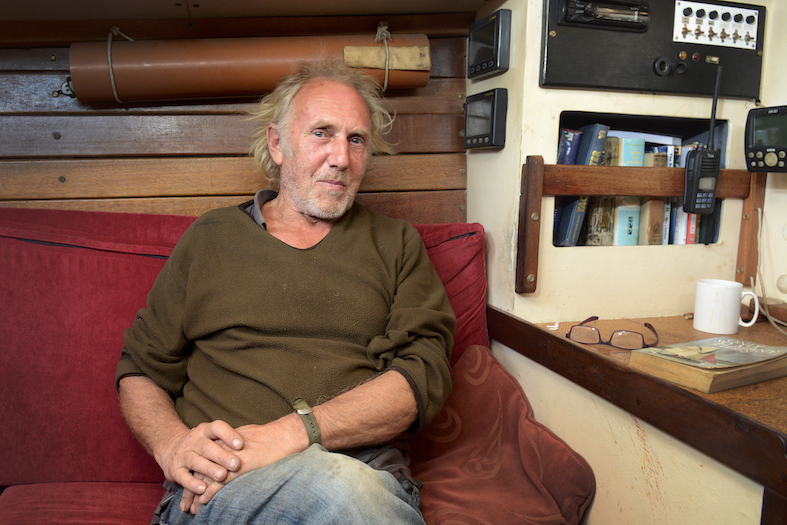
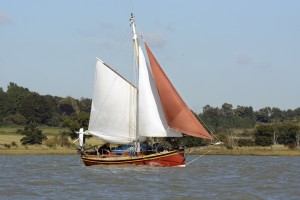
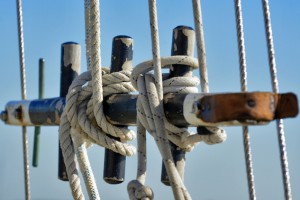



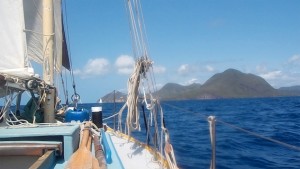
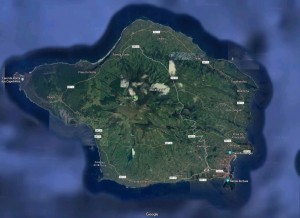
[…] This post was originally sourced from Classic Sailor and can be directly viewed here. […]